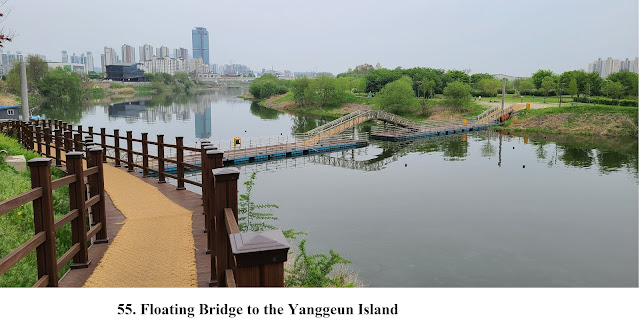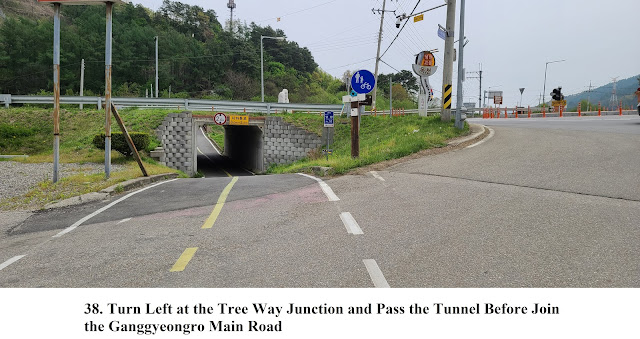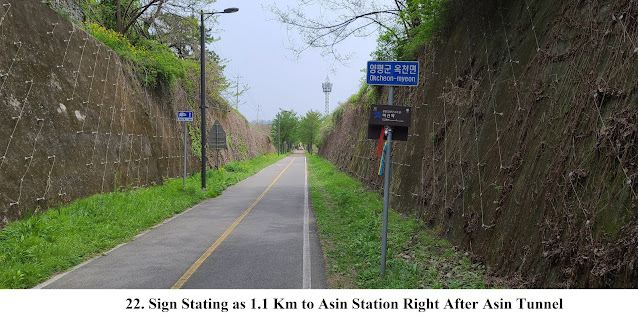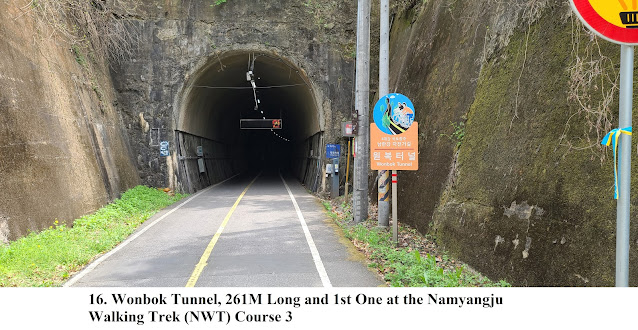1. Preface
The
Namyangju Walking Trek Course along with Bike Road was renovated with old
abandoned narrow gauge rail course and opened in 2011 as a nice Walking Trek Course
exclusive for the bike and person. This Course is linked with Dasan Walking
Trek Course from Paldang Station to Woongilsan Station in Gyeonguei Jungang
Train Line. Therefore I rearranged the Dasan Course to the Namyangju Walking
Trek Course 1 as see at the Namyangju Walking Trek Course Table attached below.
In this regards, total Namyangju Walking Trek Course turned eventually out as 44
Km and 13 walking hours including 3 hours break.
2.
Course Guide Information
Namyangju Walking Trek (NYWT) Course 3 is starting from the Guksu Station to the Yangpyeong Station in Gyeonguei Jungang Train Line (GJTL) as about 13 km distance walking alongside Bike Road for about 4 hours including 1 hour break during the Course. We will turn left at as soon as exit Gate 1 at the Guksu Station and Walking toward the Asin Station through the Wonbok tunnel and Gigok tunnel in series which takes about one hour on foot. Please see the Photo 1 through 26. You keep walking the NYWT Course 3 for about one hour again where branching to the Willow Road from the NYWT Course 3 as see at the Photo 27 through 41. You could now walk alongside with Bukhangang River until Yanggeun Island taking about half an hour as see at the Photo 42 through 54. You will now move toward the Yangpyeong Station via the Yanggeun Island and the Bank Road taking about half an hour more as see at the Photo 55 through 67. Please see the summarized map attached and linked to https://www.youtube.com/watch?v=pvTDZSjBQrY&t=55s
3. Historic and Background Information
There
are several places or spot where some cultural and historic background and
which you may feel interest or useful for your better understanding. Please refer
followings to brief explanation.
3-1) Yangpyeong City and Yanggeun Hyun Town
Yanggeun
means “Root of Willow” and Yangpyeong means “Good Balanced Willow between North
Hangang River and South Hangang River” which would be a fundamental role people
put its area name as Yangpyeong. Yangpyeong Area was seriously changed its name
for four times different Dynasty Period as Yanggeun Hyun Town in Goguryeo Period,
Binyang Hyun Town at the King Gyeongdeok in Silla Dynasty and returned to the Yanggeun
Hyun Town in Goryeo Empire Period as an original name. Yanggeun Hyun Town was
upgraded to Yangpyeong City at the King Sunjeong in Joseon Dynasty in 1908 as a
matter of merging with neighboring Jipyeong Hyun Town. There was Jisan Mountain
at the Jipyeong Town where well- known for the production of whetstone. Jipyeong
Town was originated in relation with this mountain name. There is a very famous
Yeongmunsa Temple at Sincheongri Village in Yangpyeong City which was built at
the King Sindeok in Shilla Dynasty in 913 which was once used for the Loyal
Army Base in 1907 at the Japanese ruling period and burnt out by them. This
temple was later rebuilding in 1909 which has been maintaining till now. There
is one more famous quit old gingko tree at the Yeongmunsa Temple which would guessingly
be 1,100 years old
.3-2) Asin Station
Asin
Station was newly created between two area names, the one is Aho Village and the
other Sindae Village in relation with the Administration Reorganization in
1914. There was old Asin Station positioning at right of present Asin Station
which was removed due to double track works in 2009 and which we could now see
its area at the small park near to the present station.
3-3) Yangju Area
Yangju was originally calling as Hanyang Geun District which was changed to the Yangju (same as present name) at the King Taejo in Goryeo Dynasty. This area was an always important military base where Baekje and Shilla Dynasty were continuously fighting each other. They called this area as Maeseong Gun or Maheul which was later changed to Naeso Gun, Sangju, Haju, Sapleangju and finally returned to the Yangju name at the King Gyeongeok in Shilla Dynasty.






































































댓글 없음:
댓글 쓰기